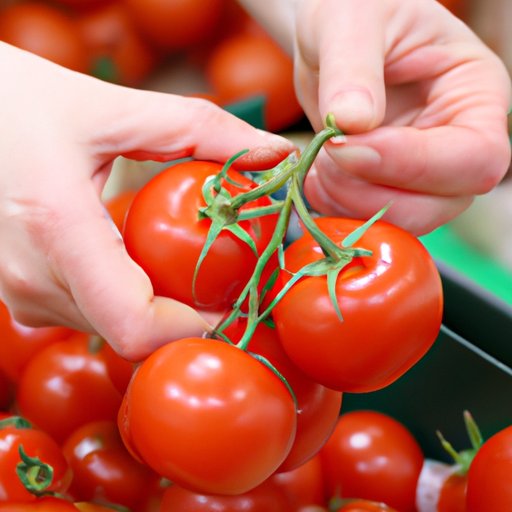I. Introduction
Tomatoes are a versatile and nutritious food item that can be used in various dishes. However, many people struggle with how to properly store tomatoes to ensure their freshness and quality. This article aims to provide readers with tips and strategies for optimal tomato preservation, including an overview of different types of tomatoes, how to choose ripe tomatoes, best practices for storing at room temperature, refrigeration, freezing, canning, and creative recipe ideas.
II. Understanding Different Types of Tomatoes and Their Storage Requirements
Before diving into storage strategies, it’s important to understand that different types of tomatoes have varying characteristics and storage requirements. For example, heirloom tomatoes are often softer and more delicate, and therefore require gentler handling and storage compared to firm, commercially-grown tomatoes. Similarly, cherry tomatoes have a higher moisture content and therefore may spoil faster if stored incorrectly.
When purchasing tomatoes, be sure to consider the type and its specific storage requirements. This will help ensure maximum freshness and flavor.

III. The Importance of Choosing Ripe Tomatoes for Optimal Storage
In addition to the type of tomato, the ripeness of the fruit also plays a crucial role in storage. When possible, it’s best to choose ripe tomatoes for optimal storage. Ripe tomatoes are softer and more flavorful, and will continue to ripen if stored at room temperature or in the refrigerator. Additionally, underripe tomatoes may not develop their full flavor even with proper storage.
To choose ripe tomatoes, look for bright, uniform color with no bruises or soft spots. The tomato should be slightly firm but give slightly when pressed. If purchasing tomatoes that are not yet ripe, store them at room temperature until they are ready to eat.
IV. Tips for Storing Tomatoes at Room Temperature
When storing tomatoes at room temperature, it’s important to keep them in a cool, dry place away from direct sunlight. A temperature range of 55-70 degrees Fahrenheit is ideal, and humidity levels should be between 40-50%.
Tomatoes can be stored on the counter or in a pantry, but be sure not to stack them on top of one another, as this can cause bruising and spoilage. Additionally, it’s important to check on tomatoes regularly and rotate them to prevent any one tomato from spoiling.
V. How to Store Tomatoes in the Refrigerator to Extend Their Lifespan
In some cases, refrigerating tomatoes can extend their lifespan and preserve their flavor. However, it’s important to note that refrigeration can also cause some tomatoes to lose their texture and flavor. Firm, commercially-grown tomatoes tend to do better in the fridge, while softer heirloom tomatoes may not hold up as well.
To refrigerate tomatoes, place them in a perforated plastic bag and store them in the crisper drawer. Be sure to avoid overcrowding the drawer, which can cause uneven cooling and spoilage. Additionally, allow refrigerated tomatoes to come to room temperature before eating to fully enjoy their flavor.
VI. Freezing Tomatoes: A Guide to Preserving Them for Later Use
If you have an excess of ripe tomatoes, freezing them is a great way to preserve them for later use. Not only does freezing extend their lifespan, but it also allows for easy use in recipes like soups, stews, and sauces.
To freeze tomatoes, begin by blanching them in boiling water for 30-60 seconds. This will help loosen the skin and preserve the color and flavor of the tomato. Then, transfer the tomatoes to an ice water bath to stop the cooking process. Once cooled, remove the skins, cut out the cores, and freeze the tomatoes whole or chopped in airtight containers or freezer bags.
Frozen tomatoes can be stored for up to 6 months in the freezer. To use them, simply thaw in the refrigerator or at room temperature before using in recipes.
VII. Methods for Canning Tomatoes to Enjoy Them Year-Round
If you’re looking for a way to enjoy tomatoes year-round, canning is an excellent preservation method. The canning process involves sterilizing jars and filling them with cooked tomatoes, then sealing tightly and processing in a boiling water bath.
To can tomatoes, begin by washing and quartering them, then cooking them briefly in boiling water to remove the skins and loosen the cores. Then, fill jars with the cooked tomatoes, leaving 1/2 inch of headspace. Add lemon juice or citric acid to each jar to ensure safe acidity levels, then seal tightly and process in a boiling water bath for the recommended amount of time.
Canned tomatoes can last for up to a year in a cool, dry place. They can be used in a variety of recipes, such as sauces, soups, and stews.
VIII. Creative Recipes for Using up Excess or Overripe Tomatoes Before They Spoil
If you find yourself with excess or overripe tomatoes, there are plenty of creative recipes that make good use of them. Some ideas include:
- Fresh tomato bruschetta
- Tomato soup
- Tomato salsa
- Pan con tomate (a Spanish-style toasted bread with tomato and garlic)
- Tomato and mozzarella salad
When cooking with overripe tomatoes, be sure to taste them first. If the tomato is overly watery or has an unpleasant texture, it may not be suitable for cooking and should instead be discarded or used for compost.
IX. Conclusion
Properly storing tomatoes can help ensure their freshness and quality for longer periods of time. Understanding different types of tomatoes, choosing ripe fruits for storage, using optimal storage methods, and getting creative with excess or overripe tomatoes are all strategies for maximizing the lifespan and flavor of this versatile ingredient.
Whether you prefer to store tomatoes at room temperature, in the refrigerator, freeze them, or can them for later use, there are plenty of options for preserving this delicious fruit.
